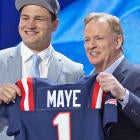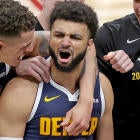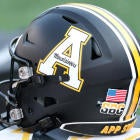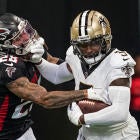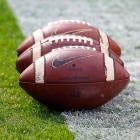1. Florida
Obviously, the Gators have a great deal of work to do for the defense to pick up where it left off in 2009. The list of those departed is quite long: Joe Haden, Brandon Spikes, Carlos Dunlap, Jermaine Cunningham, Major Wright, Ryan Stamper and Dustin Doe. The thing is, we just can't bet against a recruiting powerhouse like Florida. Former top recruits like Ahmad Black, Will Hill and Janoris Jenkins return in the secondary, making the loss of Haden and Wright appear manageable. Similarly, A.J. Jones, Brandon Hicks, Jelani Jenkins and Jonathan Bostic appear poised to provide the next wave of terror in the Florida linebacking crew. The defensive line also features plenty of big-time recruits waiting to step in. The final reason to like Florida's defense is the special teams component. Somebody out of the group of Chris Rainey, Jeffery Demps and T.J. Lawrence should emerge as a dangerous returner, adding the probability of at least one touchdown on a return.
2. TCU
Can TCU keep applying the pressure on opposing offenses without defensive end Jerry Hughes around? You have to like their chances. In fact, you have to like their chances of applying even more pressure in 2010. TCU totaled 33 sacks last year, but the team sacked opposing quarterbacks more than 40 times in each of the two years prior. They forced 36 and 41 sacks in the two respective years before that. Similarly, TCU has allowed fewer than 20 points per game in the last five years, three of those years featuring totals less than 15 points per game. This is a program that has completely perfected its craft, and history says there's just no reason to expect a drop-off. The Horned Frogs scored four times on turnovers last year, and three more on special teams returns. Expect similar performances in 2010.
3. North Carolina
The Tarheels might have the country's most talented defense. If the defense were supported by a better offense and wasn't left on the field so much, we'd probably have it at No. 1. Every line of the defense is loaded with star talent. Defensive end Robert Quinn might be the best pass-rusher in the nation, and he should be among the country's tackles-for-loss leaders after totaling 19 as a sophomore last year. He's complemented by the underachieving but still extremely talented Marvin Austin at the defensive tackle spot, and the two are sure to spend a great deal of time in opposing backfields. Quan Sturdivant, Bruce Carter, Zach Brown and Kevin Reddick provide a ridiculous linebacker unit, while the backfield is led by playmakers Deunta Williams and Cedric Burney. In addition, Da'Norris Searcy provides a bit of a touchdown threat as a returner. Keep an eye on Sturdivant's situation, as he was arrested on marijuana possession charges in July. If he misses any time, it could be a significant loss for the defense, though it has plenty of linebacker depth.
4. Iowa
Iowa will need to replace a few important players in cornerback Amari Spievey and linebackers Pat Angerer and A.J. Edds, but the return of defensive end Adrian Clayborn and safety Tyler Sash means this defense will remain dangerous. The vast majority of Iowa's defensive line and secondary, in fact, return in shape. With that, the framework for a ton of disruptiveness and turnover potential remains intact. The milestone of 30 sacks and 30 turnovers is within reach for Iowa, as it posted 30 and 29, respectively, in 13 games last year.
5. Alabama
Florida certainly lost many of its most valuable players from 2009, but Alabama might have won the competition to be the school that lost the most defensive talent this offseason. The team lost three of its top linemen in Terrence Cody, Lorenzo Washington and Brandon Deaderick, leaving Josh Chapman and the very promising Marcell Dareus as the only returning big men with any meaningful experience. Star linebacker Rolando McClain left school early to be a top-10 NFL pick, while the dominant cornerback duo of Javier Arenas and Kareem Jackson were both high NFL selections, as well. The good news is, like Florida, Alabama's successful recruiting has brought in tons of replacement talent. Nico Johnson, last year's five-star linebacker recruit, should team with Dont'a Hightower to make the loss of McClain barely noticeable, and the wealth of big names brought in for the defensive line and secondary should pick up not too far from where the previous group left off.
6. Ohio State
One could easily argue that the Ohio State defense will outdo Iowa's this year. We think the line is a blurry one, and our projections only slightly place Iowa and Alabama ahead of the Buckeyes. The Buckeyes lost a few important players from the 2009 squad, such as star safety Kurt Coleman, top linebacker Thaddeus Gibson and a slew of depth players on the line, but the most important players from a year ago return. The top name is definitely Cameron Heyward, a monstrous interior lineman who totaled ten tackles for loss and led the team with 6.5 sacks last year. Heyward's presence frees up other players, such as emerging star linebacker Ross Homan and defensive end Nathan Williams. Ohio State has held opposing teams to fewer than 15.3 points per game in each of the past five years, so you obviously can't go wrong with this team. In any case, we think our top-six defenses comprise the top tier of college fantasy football defenses, and any one of these six should prove to be an elite unit.
7. Boise State
Although we don't consider Boise State a top-tier fantasy defense, you should certainly feel confident if you draft it. The Broncos don't show a ton of pass-rushing ability, but they're just disruptive enough to force a great deal of turnovers. The team forced 35 turnovers in 14 games last year, and it turned four of those turnovers into touchdowns. The Broncos will have to overcome the loss of top cornerback and a dynamic returner in Kyle Wilson, but four of Boise State's returning defensive backs in Brandyn Thompson, Jeron Johnson, Winston Venable and George Iloka intercepted 13 passes last year, so there's no shortage of playmaking ability among the returning lineup. Another perk to owning the Broncos is the potential for special teams touchdowns, as Titus Young, Doug Martin and Chris Potter should combine to total at least two touchdowns on returns.
8. Pittsburgh
Pittsburgh is one of a few intimidating defenses in the Big East (see: Rutgers, West Virginia), but we are led to believe the Panthers are capable of assembling the conference's best this year. We say this despite the departure of defensive tackle Mick Williams, the heart of the Pittsburgh defense and perhaps its best player from 2009. The reason why the Panthers should overcome the loss of Williams is because the team returns a great deal of developing talent on the defensive line, including star defensive end Greg Romeus. There's also a good amount of young talent among the linebackers and secondary, so all parts of the Pittsburgh defense should be effective.
9. Clemson
The Tigers allowed a very respectable 20.4 points per game last year, and each of the four years before it they allowed less than 20 per game. This is a program that knows how to field defenses. A few players need to be replaced from last year, but the most talented players from a year ago are back. The secondary might be the strength of the unit, headlined by star safeties DeAndre McDaniel and Rashard Hall, who combined for 14 interceptions last year. It would nice to see someone step up as a pass-rusher for Clemson this year, however, because it took 16 players to account for 33 sacks in 14 games last year.
10. Penn State
After Alabama and Florida, Penn State probably lost the most talent this offseason. What was almost surely the country's best group of linebackers in Sean Lee, Navorro Bowman and Josh Hull needs to be rebuilt entirely, and the loss of defensive tackle and first-round NFL pick Jared Odrick is also huge. But like most other teams in our top-10, Penn State has a history of fielding top defenses despite the yearly loss of NFL talent. Not since 2003 has the program allowed more than 20 points per game in a season, and it only allowed 21.2 points per game in that year. The 2010 defense should be able to carry on the Penn State tradition of great defenses, because the program has pulled in a good amount of talented recruits in recent years.
Sleepers
West Virginia
We don't have West Virginia ranked far behind Pittsburgh, and really, it wouldn't be surprising if the Mountaineers ended up fielding the best Big East defense. Defensive end Julian Miller should be one of the conference's best defensive players after totaling 14.5 tackles for loss and eight sacks in 2009, while safety Robert Sands returns after intercepting five passes and breaking up eight more last year. The team also will hopefully have an instant impact at the defensive end position with the recruit of JUCO prospect Bruce Irvin, a top tier talent in the 2010 recruiting class. If Irvin could turn out to be 2010's Jason Pierre-Paul, the Mountaineer defense could be dominant.
UCLA
UCLA lost a great deal of talent this offseason; enough to rival that lost by teams like Florida, Alabama and Penn State. Defensive tackle Brian Price was one of the nation's best, totaling 23.5 tackles for loss and seven sacks. The Bosworth twins made 21.5 tackles for loss and added three more sacks. Cornerback Alterraun Verner leaves and 13 career interceptions go with him. The loss of players like Jerzy Siewierski and Reggie Carter will be tough, too. But with the return of linebacker Akeem Ayers and safety Rahim Moore, two of the 2009 squad's three best players return this year. The two combined for 14 interceptions and three defensive touchdowns last year, and they were only sophomores. In addition to those two, UCLA has top-tier talent coming in from recent recruiting classes. The Bruins hauled in eight four-star defenders from 2010 alone, and that's not to mention five-star defensive end Owamagbe Odighizuwa. The 2008 and 2009 classes were similarly impressive. If these new recruits perform at the level they're expected to, UCLA finishing among the top-10 defenses wouldn't be at all surprising.
Temple
Temple's defense probably isn't capable of stopping the BCS-type offenses it faces, but it should look relatively high-powered against its in-conference competition. The main reason to like Temple's defense this year, in any case, is its ability to disrupt and force turnovers. Defensive tackle Muhammad Wilkerson and defensive end Adrian Robinson totaled 24.5 tackles for loss and 18.5 sacks last year. That pair should be similarly dominant in 2010, and the pressure they apply on opposing quarterbacks will allow the team's young secondary to create a good amount of turnovers. In 2009, 12 Owls intercepted passes, and the five of them who graduated totaled just five of the team's 16 interceptions. Players like Marquise Liverpool and Jaiquawn Jarrett, who combined for six interceptions last year, should be able to pick up that slack and create more turnovers this year.
Busts
Nebraska
We have Nebraska's defense ranked in our top-25, so it's not as if we don't expect good things from it in 2010. The issue is that the Cornhuskers were the best defense in the nation in 2009, and we can't see them getting close to that level this year. The loss of defensive tackle Ndamukong Suh can't be overestimated. The once-in-a-generation destroyer in the trenches led Nebraska with 85 tackles last year, an almost impossible feat for a defensive tackle. He also added 12.5 sacks, 20.5 tackles for loss, 19 quarterback hurries and three blocked kicks. It's true that defensive tackle Jared Crick looked very good last year, but Suh can't be replaced. It just won't happen. The loss of top linebacker Phillip Dillard, defensive end Barry Turner and star safeties Larry Asante and Matt O'Hanlon will hurt plenty, too.
Arizona State
The Sun Devils quietly boasted one of the nation's toughest defenses in 2009, allowing just 21.1 points per game despite being left on the field often due to a poor supporting offense. Unfortunately, a fair amount of that defense graduated after last year, and it's not clear that the team has the ability to replace those who left. There are certainly a few good talents returning, namely cornerback Omar Bolden, linebacker Vontaze Burfict (the consensus No. 1 inside linebacker recruit from last year) and defensive tackles Lawrence Guy and Saia Falahola. Still, three of the team's top four defensive backs need to be replaced and, despite his down year last season, defensive end Dexter Davis needs to be replaced as the team's top edge-rusher. We think Arizona State will allow around 25 points per game this year as the offense will once again be a liability, and just enough talent has left the defense to leave it vulnerable.
South Carolina
South Carolina's defense will be fairly talented this year, but the issue is that it plays in the SEC. Being “just good” means nothing — you need to be exceptional to survive. The team lost its top pass-rusher in linebacker Eric Norwood, and top run-stuffing lineman Clifton Geathers was a surprise early entrant in the NFL Draft. Players like defensive end Cliff Matthews and defensive back Stephon Gilmore should be stars this year, and there's a nice group of solid recruits ready to see the field, but we think they might be a bit too green in 2010 to outperform SEC defenses like Florida, Alabama, Mississippi, LSU and maybe even Georgia and Mississippi State.
Kickers
1. Caleb Sturgis, Florida
Sturgis only made 73.3 percent of his field goals last year, but he receives so many attempts that he remains in the top tier. Sturgis went 22-of-30 and is in an offense that will be similarly explosive in 2010, meaning he should receive a similar number of opportunities. Another point that makes Sturgis a top-tier kicker that he has some range – he hit all three of his kicks in the 40-yard range and was 2-of-5 beyond 50 yards.
2. Grant Ressel, Missouri
Ressel was ridiculous in 2009, making all but one of his 27 field goal attempts, which put him at 96.3 percent for the year. He also made all 39 of his PATs. The Missouri offense should be relatively strong again in 2010, and Ressel's consistency means his team will have no reservations at all about putting him on the field. The one issue with Ressel is that he didn't attempt any kicks over 50 yards in 2009, so his range is probably limited.
3. Alan Gendreau, Middle Tennessee State
Gendreau is heading into his third year as Middle Tennessee's starting kicker, and he showed good improvement during his sophomore year in 2009. He made 18-of-22 field goals (81.8 percent) and made all but one of his 51 PATs. The main reason he's ranked this high is his team's offense figures to be very good this year, and he should have a bunch of opportunities.
4. Ross Evans, TCU
Evans has been very good since taking over the kicker spot at TCU in 2008. He made 80 percent of his field goals as a freshman and then made 15-of-18, good for 83.3 percent, in 2009. The TCU offense should be at least as good as it was last year, and so it wouldn't be surprising if he got a few more field goal opportunities this year. At the very least, you know he'll be kicking a lot of PATs (he was 61-of-63 last year).
5. Kai Forbath, UCLA
In the real college football world, Forbath might be the best. He made 28-of-31 field goals last year (90.3 percent), and all three of his misses were from 50 yards or more. He was 22-of-22 from 49 or less, and still hit three of his attempts from beyond 50. If the UCLA offense were better, Forbath would be ranked No. 1.
6. Justin Kahut, Oregon State
Although Forbath is easily the best in the Pac-10, Kahut is no slouch, either. He made 22-of-27 in 2009, registering 81.5 percent. He also showed a bit of range, going 1-of-3 beyond 50 and 9-of-11 from beyond 40. The Oregon State offense will provide plenty of opportunities as long as the Rodgers brothers are around.
7. Blair Walsh, Georgia
If there is a kicker who can compete with Forbath in the real world, it's Walsh. He was also spectacular last year, hitting 20-of-22 field goals (90.9 percent) and making all but one of his five attempts from beyond 50 yards. Look for the Georgia offense to improve in 2010, hopefully resulting in more opportunities for Walsh.
8. Matt Hogan, Houston
We'd have ranked Hogan higher, but there's a bit of an odd instability to his situation. He somehow made all 12 of his field goal attempts from 2009, including one from beyond 50 yards, but he managed to miss five of his PATs. That sort of unreliability could result in a kicker rotation of some kind, making Hogan a high-risk/high-reward selection, though the emphasis is probably on the reward end of that.
9. Brandon McManus, Temple
McManus was respectable in 2009, making 17-of-24 field goals for a success percentage of 70.8. Considering he was a true freshman, the results are encouraging. The reason we have him ranked this high is because he should see a good amount of opportunities in 2010. The Temple offense will run wild this year, and the team's disruptive defense will get the ball to the offense often.
10. Joe Phillips, Utah
Phillips was excellent in 2009, making 20-of-22 field goals and all but one of his 39 PATs. He didn't show any range beyond 40 yards, but his reliability from within that range means he should see lots of opportunities in what should be a good Utah offense.
Sleepers
Matt Nelson, Louisiana Tech Nelson did well as a freshman in 2009, making 12-of-16 field goals and all but one of his 43 PATs. The reason his production should really pick up in 2010 is that Louisiana Tech's new offense will be run by new coach Sonny Dykes, who previously coordinated offenses at Arizona and Texas Tech. The Bulldogs have plenty of playmakers on offense to make the new spread system a success, and Nelson should be kicking many more PATs than he did in 2009.
Kevin Fitzpatrick, Tulsa
Tulsa attempted few field goals in 2009, but it doesn't make any sense to stick to that plan in 2010. Fitzpatrick made all but one of his 14 field goal attempts last year, registering a success percentage of 92.9. The one kick he missed was from more than 50 yards, so he was extremely reliable from shorter ranges. But he also made one from beyond 50, so it's not as if he doesn't have range. The Tulsa offense should be better in 2010, and with that, Fitzpatrick's opportunities should increase significantly.
Cade Foster, Alabama
It's a bit of a stretch to call Foster a sleeper. He's the expected starting kicker for the national champions, and he's one of the top kicker recruits from the 2010 class. It would only be surprising if he didn't put up sizable numbers. But since most people haven't heard of him before this year, we figured it only made sense to give everyone fair warning. Alabama attempted 36 field goals last year, so this is a team that will give Foster plenty of opportunities.
Busts
Jake Rogers, Cincinnati
Rogers should be a fine kicker option in 2010, but we think he'll see fewer field goal attempts this year than he did the past couple years. Rogers has made less than 70 percent of his field goal attempts in all three years he's been at Cincinnati, so it only makes sense that the team would be a bit reluctant to use him on three-pointers in 2010. He kicked for 102 points in 2009, but we think the totals of the previous two years (84 and 82) are more likely for Rogers.
Ricky Drake, Nevada
Given the offense he kicks for, you might have assumed that Drake would be a top fantasy kicker. Unfortunately, despite kicking 64 PATs last year, Drake was only allowed nine field goal attempts. He hit only six of them, so he didn't exactly give Nevada a reason to give him more chances.
Kyle Brotzman, Boise State
This is a very half-hearted "bust" assertion, but we highly doubt Brotzman will match his 2009 total of 117 points. We think he'll drop to around his 2008 total of 101. It doesn't have much to do with him -- he'll remain a very reliable kicker from 40 yards and less, and he'll kick more than 60 PATs, too. But look for the Boise State offense to be so unstoppable that it almost never needs to kick field goals. Furthermore, Brotzman only made 68.6 of his field goals the past two years, so it's not like he's necessarily a much better option than just going for it on fourth down.











